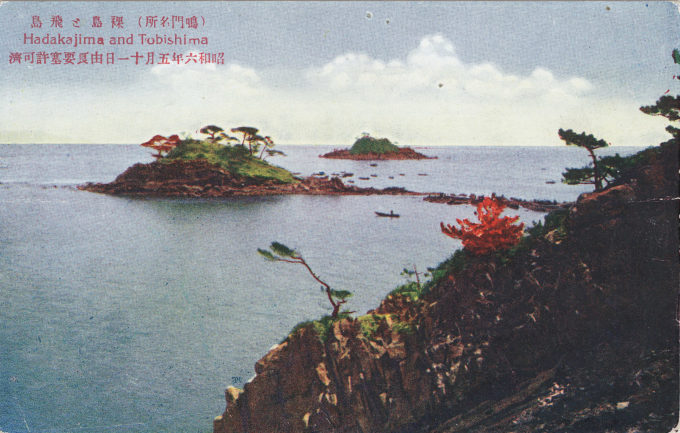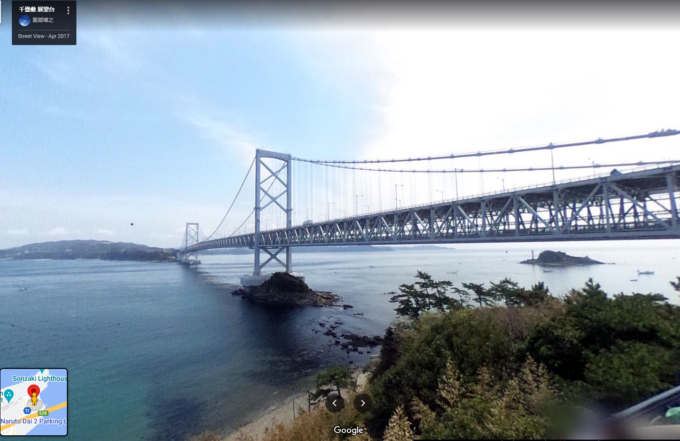
Hadakajima (left) & Tobishima (right), Naruto Strait, Shikoku, c. 1930 as seen at low tide from the overlook at Magozaki, Shikoku. This area is a popular tourist attraction, known for its recurring whirlpools known as Awa-no-Naruto (‘Roaring Gateway of Awa’) caused by tidal currents at low and high tides between Shikoku and Awajishima, where a six-foot different in the sea levels of the Seto Inland Sea and the Pacific Ocean can make for large, deep whirlpools.
See also:
Naruto whirlpools at Setonaikai, Inland Sea, c. 1910.
Round kite (wanwan-dako) flying at Naruto, Shikoku, 1935.
“The landscape of the Naruto Strait has been repeatedly selected to represent Japan, in the ‘Eight Views of Japan’ (1927), the ‘100 Views of New Japan’ (1957), ‘100 Landscapes of Heisei Era’ (2009), etc. It is protected, and was designated ‘Place of Scenic Beauty’ in 1931.
“This increased its value as a worthwhile viewing spot for a ‘strait consisting of hilly forests, coasts and islands overlooking an ocean view well-known for whirlpools.’ [But] concerns have been voiced regarding the significant changes in the landscape due to the construction of Onaruto Bridge (1985) and tourism development in the [area].
“… Magozaki is a viewpoint area looking down upon the strait that has been familiar since early times. [T]his viewpoint area had a significantly high frequency of occurrence of the two islands of Hadakajima and Tobishima. It was appreciated as a miniature garden landscape wherein the two islands of Hadakajima, connected to Choshinoguchi, and Tobishima in the background overlapped.”
– A Study of Viewpoint Areas and Landscape Features of Modern-day Naruto Strait as Seen in Postcards, by Ohira Kazuhiro, Journal of Environmental Information Science, Vol. 2, 2020

Google streetview from a similar angle (as the above postcard) of the Onarutokyo Bridge spanning the Naruto whirlpools and Hadakajima (left), and Tobishima (right), 2017. Completed in 1985, the bridge has a main span of 2,874 ft. and was, until the 1990s, one of the longest suspension bridges in the world. When first built, space was left for the proposed Shikoku Shinkansen; however, no progress was been made on the train line, so the space intended originally for the bullet trains is instead an enclosed walkway used as an observatory to view the Naruto whirlpools beneath the bridge.
“At the further end of this little bay a bold wooded bluff projects into the sea, to the summit of which was a well-trodden path. From the platform at the top, we had a lovely view of the opening of the Inland Sea and its countless islets. Descending on the other side, after gathering a dozen species of ferns I had never before seen, we found ourselves at Naruto, one of the lions of Japan.
“Here the tide coming up the Inland Sea meets the tide from the north …Its narrowest part is about a mile and a quarter wide, but a rocky island divides the strait into what are called the Greater and Lesser Naruto, the Greater Naruto being on the Shikoku side.
“We must remember that the tidal wave, rolling from west to east, strikes the north and south entrances of the Inland Sea almost simultaneously; but Naruto being near the northern opening, the tidal wave reaches this narrow channel from the north long before the arrival of the southern wave.
“The consequence is that at high water from the north, the sea is twelve feet higher on the northern side of the channel than it is on the inside, by a sort of bore being arrested here, but at low water the conditions are reversed, and the tidal wave having now come up from the south, the water north of the strait is twelve feet lower at an ordinary spring tide. The [result] is that there is literally a waterfall across the sea, excepting for a few minutes at mid-tide, when it is level.
“… [T]here, standing on a flat rock at the extremity, the sea on our right hand was several feet higher than on our left, and the line in front of us was an even cascade more than a mile long, and as we watched it the waterfall gradually diminished in height. We went on shore, and after spending an hour or two botanising in the woods, returned to our post of observation to find the cascade barely more than a foot in height.
“Large shipping dare not risk this dangerous passage, but lighter craft can easily shoot the falls either way. We watched two junks trying it. They were gradually drawn faster and faster, as the current bore them down, till at last they ducked to it, seemed to take a header, and instantly come up again, and were then swept down stream at a tremendous rate. I have shot the rapids in the St. Lawrence, but none of them were like this.”
– Rambles in Japan: The Land of the Rising Sun, by H.B. Tristam, 1895

